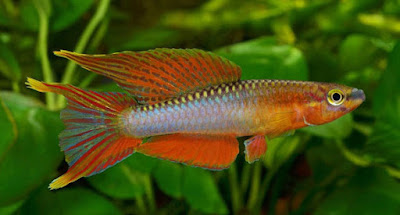A killifish is any of various oviparous (egg-laying) cyprinodontiform fish (including families Aplocheilidae, Cyprinodontidae, Fundulidae, Nothobranchiidae, Profundulidae, Rivulidae and Valenciidae). Altogether, there are some 1270 different species of killifish, the biggest family being Rivulidae, containing more than 320 species. Although killifish is sometimes used as an English equivalent to Cyprinodontidae, some species belonging to that family have their own common names, such as the pupfish and the mummichog. The origin of the name is not certain, but is likely to have come from the Dutch for a kill. Because of living in ephemeral waters, the eggs of most killifish can survive periods of partial dehydration. Many of the species rely on such a diapause, since the eggs would not survive more than a few weeks if entirely submerged in water. Like seeds, the eggs can be sent by mail without water. The adults of some species, such as Kryptolebias marmoratus, can additionally survive out of the water for several weeks. Most killies are small fish, from one to two inches (2.5 to 5 cm), with the largest species growing to just under six inches (15 cm).
The Nothobranchius killifish prove to be interesting to fish hobbyists. Caring for the Nothobranchius killifish is not all that hard but they do require a little extra attention than the common Aphyosemion Killifish species.
A minimum aquarium of 10 gallons (37.8 liters) is required for every three killifish of any this species. They prefer soft water, with a pH of 6.0 to 6.5 and a water temperature of 70-80 F (21-27 C). Decorations, including live plants and rocks, set up in a way that would provide shelter when needed helps in making an ideal home for these fish.










No comments:
Post a Comment